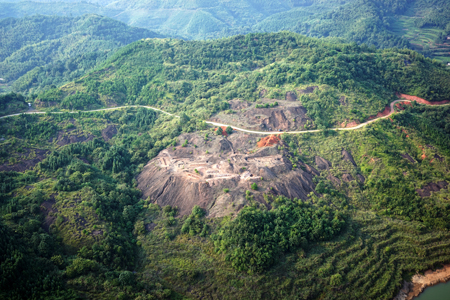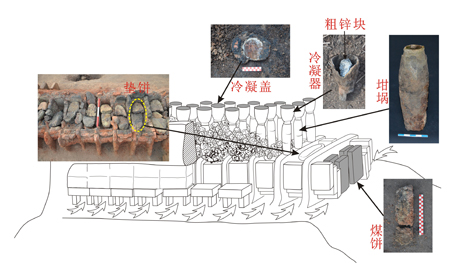The Discovery of Zinc Mining and Metallurgy Site in Hunan Province
From:Chinese Archaeology NetWriter:Date:2017-04-18
From July to December in 2016, 14 large Zinc mining and metallurgy sites in Guiyang district were surveyed by Hunan Institute of Cultural Relics and Archaeology cooperates with Peking University School of Archaeology and Museology and other organizations. Intentional excavation of Tongmuling site was hence carried out. The survey and excavation revealed a number of intact, large-scaled zinc and multi-metal smelting sites, unearthed a series of important smelting remains, encouraged our understanding of smelting technology during Ming and Qing dynasties, which therefore promoted the archaeological research on crafts production.
The aerial photo of Tongmuling site
Excavation Results
Tongmuling site is situated in Renyi Town, Guiyang County. The total area of the site is around 110,000 square meters. There is a platform formed by slag in the center of the site. The surface of the platform is triangular, with a length of 100 meters from the east to the west and a width of 50 meters from the south to the north. According to the excavation, a burning unit and two smelting unites on the platform presented a “品” shape, show that the mines were burned first and then smelted.

The melting workshop
The burning unit is located in front of the platform (south part) and distributed in an oval shape with a length of 55 meters from the east to the west, a width of 20 meters from the south to the north, and a total area of about 1100 square meters. There are 6 burning stations distributed according to the topography in the burning unit. Each burning station consists of 4 or 8 cylindrical burning furnaces. The burning furnaces have similar size, with a diameter of around 0.9 meters at the opening and a preserved height of 0.8 meters. The wall is relatively straight and the bottom is flat. There is a ventilation opening on a side of the furnace.

The map illustrated the smelting process
The first smelting unit is located in the east part of the platform and distributed in a round-cornered rectangular shape with a length of 55 meters, a width of 25 meters, and a total area of about 1300 square meters. In this unit, No. 1 channel furnace smelting workshop is preserved more complete. The channel furnace is the main body of the workshop and surrounded by remains such as the storage pit, mixing pit, stirring pit, and raw material pile.
The second smelting unit is located in the southwest part of the platform. In this unit, there are 3 smelting workshops with the channel furnace as the main body. The workshops are all connected with the road surface; therefore, they are suggested as the remains from same time period. The structure, design, and size of each workshop are similar to No. 1 channel furnace smelting workshop in the first smelting unit. According to the investigation, the collapse of the southwest part of the third channel furnace was probably caused by coal mining in modern times.

On the river bed, which is thought to be an ore wash-up trough
A series of relatively intact smelting tools such as crucible, condensation pocket, condensation appliance, condensation lid, iron shovel, crooked chisel, and anvil were uncovered from the smelting working area. On the other hand, green graininess scattered slag and lumped corrugated slag were found. Also, furnace remains (K23 and K24) with a high content of copper, lead, and silver, as well as a suspected plank of circular bellow piston, were recovered at the correspondence positions to the slag. It is suggested that this is a multi-metal smelting site mainly used for zinc-smelting and combined with smelting of lead, copper, and silver.
Daily utensils and a small quantity of coins belong to Qianlong and Jiaqing periods of Qing dynasty were recovered from the housing and working areas. It is initially suggested that the site began to use in the late Ming and early Qing dynasties and abandoned in the late Qing dynasty.
The archaeology team has investigated the surrounding areas of the Tongmuling site. Test excavations were also carried out to the sites with important signs and a double-lined furnace with a length of around 20 meters was recovered. This is the first time that this type of furnace found in China. On the other hand, remains related to zinc-smelting such as burning furnace, channel furnace, and housing remains were found.
Value and significance
The discovery and excavation of the entire platform in the center of the site indicates the function and structure of the smelting site. This is very important to the understanding of the function division, technological process, production capacity, and the daily life and productivity of the workers.
The discovery of lined round shaped furnaces has filled in the gap in the research of zinc-smelting technology in China. The channel furnaces recovered from the site are the most completed Qing dynasty zinc-smelting furnaces found in China. The remains of zinc-smelting and metallurgy uncovered with the furnaces dovetailed with the historical literature. It is very significant to the reconstruction of ancient zinc-smelting technology. The investigation and excavation result is a treasure to the research of Chinese metallurgical history, coin history, and political-social history. (Translator: Li Xuelei)

